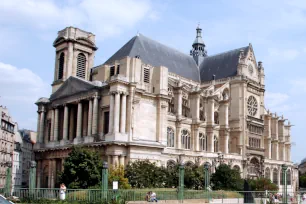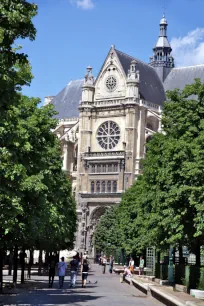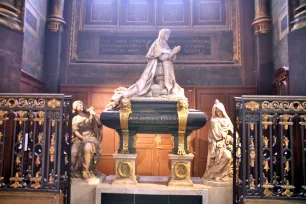The Gothic St. Eustache Church is one of the largest churches in Paris. The sixteenth-century church is best known for its beautiful interior decorations in Renaissance style.
History of the Church


Located in Paris’s 1st arrondissement, it took 105 years to build the grand St. Eustache church. Designed by architect Domenico da Cortona of Italy, it was constructed between 1532 and 1637.
The church, in the Les Halles (market) area of Paris, actually had its start in 1223, when in exchange for lending king Philippe Auguste a large amount of money, local merchant Jean Alais was allowed to charge tax on baskets of fish. Amassing a good fortune, he used part of the money to build a chapel. The chapel – named for St. Agnes – received the status of a church and in 1303 it was named in memory of St. Eustace, a Roman general who was burned at the stake for his conversion to Christianity.



The current building was not constructed until centuries later, at the suggestion of Jean de la Barre, provost of Paris, who laid the first stone of a new church. A new facade was added in the eighteenth century.
During the French Revolution, the church was used for agricultural purposes and was looted and desecrated, as were many other religious structures in the city. However, some important works of art survived, such as a painting by Rubens.
St. Eustache has had a number of notable parishioners over the centuries. Louis XIV made his first Communion there; Cardinal Richelieu and Jeanne-Antoinette Poisson, the future Madame de Pompadour, were baptized at St. Eustache; and Mozart chose the church for the funeral of his mother. In addition, Molière was married at this cathedral.
Architecture
The building measures 105 meters (344 feet) long, 43.5 meters wide (143 feet) and with a vault soaring 33.5 meters (109 feet) high. The cupola on top of the church reaches a height of about 58 meters (190 feet). The church follows a ground plan similar to that of the Notre-Dame Cathedral, with a nave of five bays and a choir aisle with 24 chapels.
The style of St. Eustache is Gothic, not unlike Notre Dame. However, during its long construction time, the Gothic style had gone out of fashion and Renaissance was the new style of choice. Hence, the church does boast a great deal of Renaissance detail, especially the decorations and the arches.
Interior


The beautiful stained-glass windows, created by Soulignac in 1632, are probably modeled after drawings of Philippe de Champaigne. The church also contains many paintings such as Tobias and the Angel by Santi di Tito and an early work by P.P. Rubens, Pilgrims of Emmaus. A tomb designed by Le Brun holds the body of Jean Baptiste Colbert (†1683), French minister of Finance in the seventeenth century.
The organ in the sanctuary is the largest pipe organ in France, boasting some 8,000 pipes. The music program is exemplary at the church, and organ and choral recitals and concerts are frequent.
Location
The church is located at the center of historic Paris, near an open square adjacent to the Forum des Halles not far from the Centre Pompidou. The unusual L’Écoute sculpture by Henri de Miller sits at the center of the square and attracts plenty of attention.
- Next: Place du Châtelet
- More Paris Churches
- More Sights & Attractions in Paris

